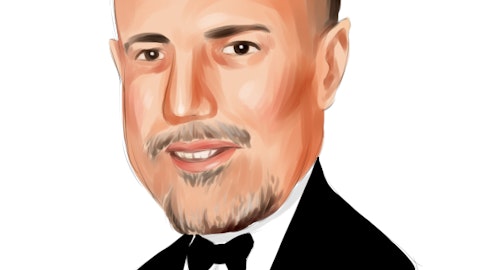Ita Brennan: Yeah, I mean a lot of it is timing, right? We’ve got a lot of different projects, a lot of different products kind of filling through the R&D labs right now, so there is going to be some kind of volatility in terms of when the spend shows up, when the proto spend happens, et cetera. So I think we were lower this quarter in Q3 than maybe we even anticipated coming into the quarter. I expect that to come back and kind of the guide for Q4. And again, there may be some volatility in that even going forward, just because it’s all about timing, nothing unusual in that. There’s just a lot of products kind of going through the R&D labs.
Jayshree Ullal: So, Michael, when the chips are down, our spending is down, but when the chips come on hot, our spending gets hot too. So, expect our prototypes to have some high variability and we’ve got a lot and lot of new products in the pipeline that Andy, Anshul, Ken, you are all working on. So, we expect that number to go up over the next four quarters.
Michael Ng: Great, very helpful. Thanks, Jayshree. Thanks, Ita.
Operator: Your next question comes from the line of Atif Malik with Citi. Your line is open.
Atif Malik: Hi, thank you for taking my question. Jayshree, at the recent Open Compute Project Conference, Marvell and Broadcom, leading Ethernet switch merchant chip providers sounded very confident in terms of Ethernet adoption at hyperscalers like Meta and Oracle as well. And one of your peers has talked about 500 million in AI orders, whether it’s custom chip. So, I was curious about your thoughts on the dynamics between custom chip and merchant switch chip providers, and how does that help Arista? Thank you.
Jayshree Ullal: Yeah, Atif, we have been strong proponents in our last 15, 17 years of Arista Korea on merchant silicon. We look for the best of breed chips. It’s something my team, engineering team, has built a lot of chips in their past before, but we decided to work with the best of breed companies, Broadcom being one of our favorite and major suppliers. Of course, in the past, we worked with Intel, Cavium, and we don’t rule out other suppliers as well. But this is clearly an area where you can’t just build one chip, you have to build a portfolio of silicon. And what Broadcom has done in building that portfolio not only for cloud networking, but for campus and AI is impressive. And you have to not just look at performance, you have to look at price, density, power.
These are all very important metrics as we look ahead. The root issue here, and we’ll share this more with you going forward as well, is not just the merchant silicon, but how you can enable the merchant silicon with the right software and drivers. And this is an area that really Arista excels in. If you just have chips, you can’t build a system. But our system-wide features, whether it’s in dynamic load balancing or latency analyzer to really improve the job completion time and deal with that frequent communication and generative AI is also fundamentally important. You’re going to hear a lot more about this next week, so stay tuned.
Atif Malik: Thank you.
Operator: Your next question comes from the line of Ben Reitzes with Melius Research. Your line is open.
Ben Reitzes: Yeah, hey, thanks for the question. Jayshree and Ita, can you discuss a little more your gross margin commentary that it should moderate next year from the 63% levels in the back half? I mean, are we talking about it going to the first half ’23 kind of levels, or just a little bit of a degradation next year? And what would be the reason behind it? Other than lead times, is there any other mix or other issues that would cause it to go down? Thanks.
Ita Brennan: So, Ben, I think what Jayshree commentary, my commentary, is we have been seeing it incrementally improve as we’ve gone through the year. We expect it to stabilize. So not that we expect it to go down next year, but more that it will stabilize. And then it will become more dependent on customer mix and other thing again, similar to where we’ve been before. But obviously, we’ll provide more outlook on — discussion on this next week too. But the intention was not to say that we think it starts to decline again. It was more that we think it will stabilize after a period where we’ve been seeing these incremental improvements.
Ben Reitzes: Okay, thanks a lot. Appreciate the color.
Liz Stine: Thanks, Ben.
Operator: Your next question comes from the line of Tim Long with Barclays. Your line is open.
Tim Long: Thank you. I just wanted to hit on the cloud titan vertical or cloud titan AI vertical now if I could. I think, Ita, one of your comments was down a little or something in the quarter. Could you just — two parts here, talk a little bit about that comment? Is this just timing or are there some different market share dynamics there? And then, secondly, if you could talk a little bit about opportunities at other hyperscalers? I know that’s something where there’s been trial activity and potential and sounds like it might take a little while, but any updates on other cloud titans that could become larger customers? Thank you.
Ita Brennan: Just in terms of cloud, I mean, it’s going to be a good cloud year again in 2023 for us, I think, but we did come into the year saying we wanted, if we could to balance supply a little bit towards enterprise. And we have been doing that. There’s been some — you’ll see it, it’s not a huge mix shift, but there has been some mix shift towards enterprise when we can, and we’re pleased that we’ve been able to do that. Anshul, I don’t know if you want to take the other cloud.




